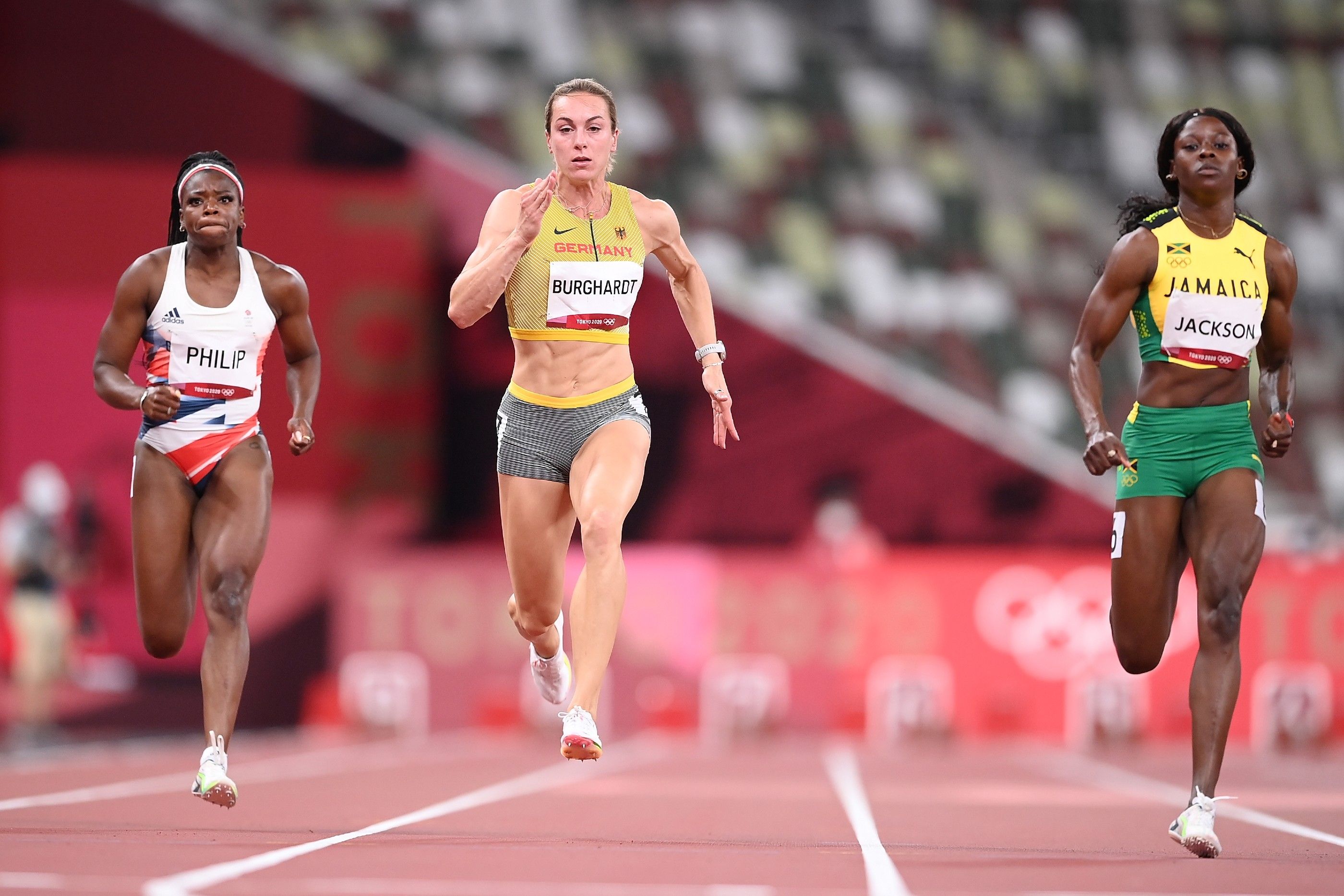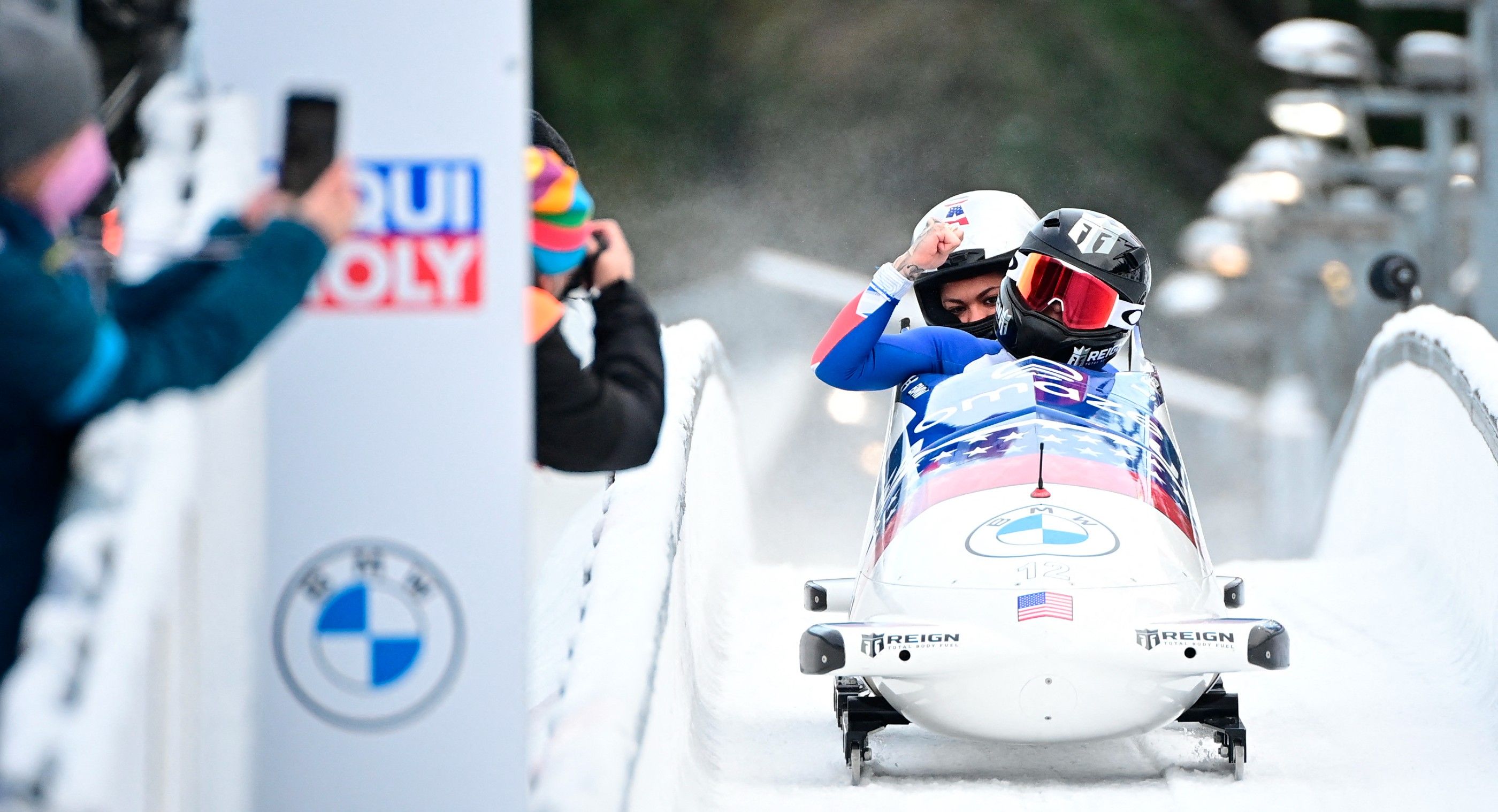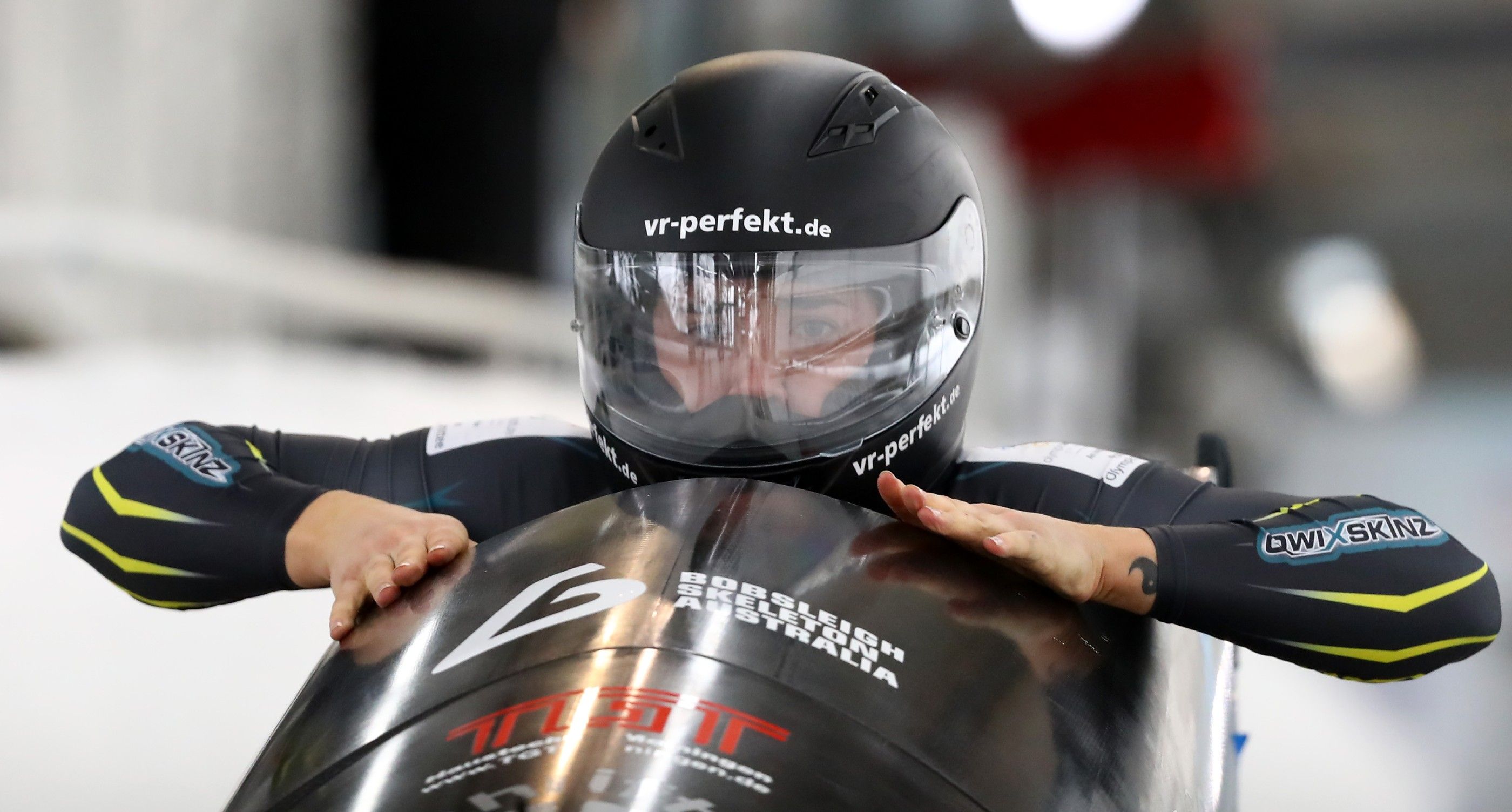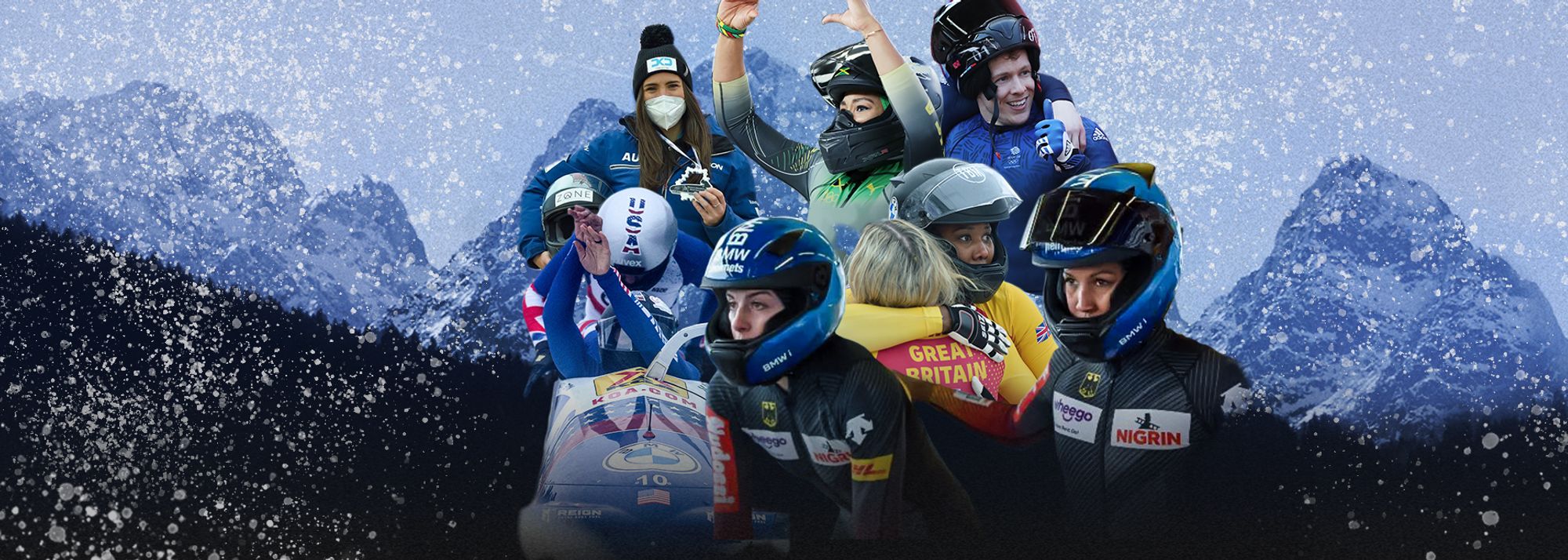Beijing-bound Winter Olympians with roots in track and field (© Viesturs Lacis for IBSF / Getty Images)
For a select group of track and field athletes, 2022 is an Olympic year.
It won't be like the Games in Tokyo last year, though, nor the edition set to take place in Paris in 2024. Instead, for a handful of athletes who have swapped their starting blocks or throwing implements for a bobsleigh or skeleton, their immediate focus will be on the upcoming Winter Olympic Games, taking place in Beijing from 4-20 February.
Take a look through the entries for many of the events due to take place in Beijing, and you'll likely spot a few familiar names from the sport of athletics. In the bobsleigh, for example, where speed and strength are key, it's easy to see why many sprinters, combined eventers and throwers make the switch to that sport. Several cross-country skiers, meanwhile, particularly those from Scandinavian countries, have a background in endurance running. There are also athletics cross-overs with sports like speed skating and skeleton.
It’s little surprise, though, that a sport like athletics – where the basic principles of movement are at its core – can open up opportunities for other sporting careers. It has also meant that nations with little history in winter sports are now competitive on the world stage. Jamaica, for example, will be fielding bobsled teams in Beijing, and several team members come from a sprints background. The same is true for Nigeria and their skeleton and bobsled teams.
In fact, examples can be found in all corners of the globe. And here are four such athletes.
Alexandra Burghardt | Montell Douglas | Kaysha Love | Bree Walker
Schedule in local time
Thursday 10 February
9:30 - men’s skeleton, heat one
11:00 - men’s skeleton, heat two
Friday 11 February
9:30 - women’s skeleton, heat one
11:00 - women’s skeleton, heat two
20:20 - men’s skeleton, heat three
21:55 - men’s skeleton, heat four 🥇
Saturday 12 February
20:20 - women’s skeleton, heat three
21:55 - women’s skeleton, heat four 🥇
Sunday 13 February
9:30 - women’s monobob, heat one
11:00 - women’s monobob, heat two
Monday 14 February
9:30 - women’s monobob, heat three
11:00 - women’s monobob, heat four 🥇
20:05 - two-man bobsleigh, heat one
21:40 - two-man bobsleigh, heat two
Tuesday 15 February
20:15 - two-man bobsleigh, heat three
21:50 - two-man bobsleigh, heat four 🥇
Friday 18 February
20:00 - two-woman bobsleigh, heat one
21:30 - two-woman bobsleigh, heat two
Saturday 19 February
9:30 - four-man bobsleigh, heat one
11:05 - four-man bobsleigh, heat two
20:00 - two-woman bobsleigh, heat three
21:30 - two-woman bobsleigh, heat four 🥇
Sunday 20 February
9:30 - four-man bobsleigh, heat three
11:20 - four-man bobsleigh, heat four 🥇
Alexandra Burghardt 🇩🇪 – two-woman bobsleigh
18 February: heat one and heat two, 19 February: heat three and heat four
Making an Olympic Games is a great achievement. Qualifying for two, in two different sports within just seven months, really is something else. But that’s exactly what Alexandra Burghardt has done.
Even more remarkably, she only tried one of the sports for the first time in September.
Back in August last year, the 27-year-old sprinter was representing Germany in the 100m and 4x100m at the Tokyo Games. After being a reserve for the relay at the 2016 Olympics in Rio, her individual team place in Tokyo was a childhood dream realised. Once there, she reached the 100m semifinals and helped the relay team to fifth place in the final.
The following month she took to the ice, and her bobsleigh journey began. Now she is preparing to join pilot Mariama Jamanka – the reigning Olympic champion, herself a former discus and hammer thrower – as a brakewoman in the two-woman bobsleigh at the Beijing 2022 Winter Olympic Games.
“It is still a bit surreal,” she said ahead of her departure for China, the country in which she made her senior World Athletics Championships debut in 2015. “I have trained for my Olympic dream for years now.
“Making the team last year in Tokyo was a childhood dream come true. It was such an overwhelming and emotional experience for me, that thinking of a second Olympics is just crazy. I just wanted to feel all the emotion again and again. It’s like an addiction!"

Alexandra Burghardt and Mariama Jamanka (© Viesturs Lacis for IBSF)
A sporty child, Burghardt took up tennis initially and then moved into athletics at the age of nine. Starting out in combined events, she decided to focus on the sprints, hurdles and jumps. By the age of 19 – after competing in the 100m hurdles at the 2011 World U18 Championships and the 2012 World U20 Championships – she was a dedicated sprinter.
And Burghardt won't be the only German athlete from those 2012 World U20 Championships competing in Beijing, with Thorsten Margis, a 7707-point decathlete who finished fourth then in Bydgoszcz, contesting the two-man and four-man bobsleigh at the Games.
“I had a few good indoor races – I went to the European Indoor Championships in Prague and Belgrade (in 2015 and 2017) – but it was never possible for me to show my potential outdoors because there was always some injury and I could never train the way we wanted,” said Burghardt.
Before her series of PBs in 2021, Burghardt’s 100m best had also dated back to 2015, when she ran 11.32 in Wetzlar. Last year, however, she improved it to 11.01. It was a result of the work she had put in with her coach Patrick Saile, as well as her CrossFit physiotherapist to build strength and a mental coach, over the past few years. Everything had come together.
Burghardt had been approached in the past about joining the bobsleigh set-up, but with athletics being her passion, she always said no. Until last year.
“I never wanted to do it, because it was like flying from my actual sport. I wanted to show my potential in sprints first before starting a new adventure,” she explained. “But this summer changed everything.”
She had her first push test the day before the ISTAF athletics meeting in Berlin in September and her first race in November. In December, she and Jamanka secured double IBSF World Cup silver.
“Getting to know Mariama was pretty exciting because she is the reigning Olympic champion and she was looking for a fast brakewoman for the Olympic season, so that really motivated me to give it a try,” said Burghardt. “What I have learnt in bobsleigh is that everything is possible. Driving with a pilot like Mariama, she knows how to win.”
This doesn’t mean Burghardt is turning her back on athletics, however. Whatever happens, she hopes to compete at her national indoor championships later this month, before her focus turns to the outdoor season which features the World Championships in Oregon and a European Championships on home soil in Munich.

Alexandra Burghardt at the Tokyo Olympics (© Getty Images)
While her athletics background means Burghardt has many of the attributes needed for the winter sport, such as speed and power, being in bobsleigh has also taught her things she can take back to the track.
“The warm-up (in bobsleigh) is very difficult, of course, because you don’t have a track near the race courses. But it works,” she said. “I was really afraid, because sprinters especially are always very explicit with their warm-up and it takes us hours to get ready for a 100m race. But it showed me that it is possible, and you can warm up in minus degrees in snow and still perform. It has helped me to be more spontaneous and flexible and to accept things as they are.”
And while her supportive network and relay squad places in the past had shown her team spirit, Burghardt says that has been taken to another level in the bobsleigh.
"I have to trust Mariama completely because most tracks are 1000m long and I only run 40m or 50m," she said. "I like that, the adrenaline.
“Sometimes I feel like a double agent!” she added, on combining the two sports. “It’s quite stressful and if you want to compete at a high level in both things for more than just four months – like I am doing right now – then I think it might get a little bit too much.
“I really want to focus on track and field after the Olympics again and I don’t consider at the moment any other bobsleigh stuff in the future. But never say never!”
Montell Douglas 🇬🇧 – two-woman bobsleigh
18 February: heat one and heat two, 19 February: heat three and heat four
When Montell Douglas last set foot in Beijing, it was for the 2008 Summer Olympics.
Aged 22 at the time, and having broken the British 100m record with 11.05 earlier that season, she reached the second round of the 100m and the final of the 4x100m.
Fourteen years on from her Summer Games experience, Douglas will return to the Chinese capital to compete at the Winter Olympics in the two-woman bobsleigh.
She may well be older and wiser now compared to when she made her Olympic debut back in 2008, but Douglas was just as giddy with excitement when she was kitted out for the upcoming Winter Games.
“Being back on a British team is the thing that initially got me hooked on the bobsleigh,” said Douglas, who travelled to the 2018 Winter Olympics as a reserve. “I also have a love of anything mechanical and fast, especially cars, and to me it was like a Formula 1 car on ice.”

Montell Douglas (© Viesturs Lacis for IBSF)
In 2016, just weeks after finishing eighth in the 100m at the British Olympic Trials, Douglas was encouraged by former athletics coach Michael Khmel to try the bobsleigh. “I had no idea what it even was before then, but I broke the women’s GB testing record,” recalled Douglas. “Within six months, I was on the ice and competing for Great Britain. And in my third ever race, we won the Europa Cup event in Winterberg, the first victory for seven years by a British pair.”
In that race, Douglas teamed up with Mica McNeill, a former schoolgirl discus thrower who had earned silver at the 2012 Winter Youth Olympics in the two-girls bobsleigh alongside Jazmin Sawyers, now an international long jumper.
Along with Douglas and McNeil, Britain’s squad for this year’s Winter Olympics includes Adele Nicoll, a 17.17m shot putter, and Greg Cackett, a 10.24 100m sprinter.
There’s a reason why athletes from a strength and speed background suit the bobsleigh, explained Douglas.
“Bobsleigh is a combination between being a weightlifter and a sprinter,” she said. “That being said, the similarities lie mainly in the running part. You want to practice maximum velocity for when the sled gets going, but ‘hitting’ the sled also has very similar angles to a sprinters’ acceleration, just not as deep.
“One main difference is that you have to do all this in minus degree weather. Temperatures can plummet to the -20s and sprinting is not easy in this kind of cold. Most, if not all, elite sprinters would never run or train in these conditions.
“Bobsleighers come in all shapes and sizes – from rugby players, to military personnel,” she added. “Some people aren’t athletes when they come into the sport but get amazing results. It’s not one size fits all.”

Montell Douglas at the Beijing 2008 Olympics (© Getty Images)
Although Douglas’s natural speed is her best attribute when it comes to the bobsleigh, the training is still quite different.
“During bobsleigh now I sprint much shorter distances and I only ever cover about 50-60m of running,” she says. “I lift a lot heavier weights in bobsleigh, because instead of pulling my 67kg frame down a 100m track, I’m now pushing 170+kg of carbon fibre on ice. The power elements and plyometrics are relatively the same, but being 10kg heavier than when I was sprinting makes it a little bit harder to get off the ground.”
The current season hasn’t been an easy one for Douglas and her teammate McNeil. From illness and injury to Covid restrictions and reduced qualifying windows, the past 12 months – much like a first outing on a bobsleigh track – has been a bit of a bumpy ride.
“It was great to get the first qualification box ticked in the first race, but following on from that there were a multitude of unfortunate circumstances which meant that it wasn’t the pleasant journey we anticipated or hoped for to get to the Olympic Games,” said Douglas.
But now, having finally reached this point, Douglas is simply raring to go.
“Although I was reserve for the 2018 Winter Olympics, I made the most of my time there and absorbed most aspects of the Games,” she said. “But now I’m excited about getting in my race suit, putting my helmet on and racing down the track.”
Kaysha Love 🇺🇸 – two-woman bobsleigh
18 February: heat one and heat two, 19 February: heat three and heat four
Kaysha Love’s journey to the Beijing 2022 Winter Olympic Games was like a trip down a bobsleigh track: full of twists and turns and exceptionally fast.
Growing up in Herriman, Utah, a suburb of Winter Olympics hub Salt Lake City, Love always dreamed of going to the Games. Winter sports, though, were too “chilly” for her liking. Love was a gymnast and then became a sprinter and high jumper.
“That Olympic desire and dream followed me through each and every sport,” she said, “but I genuinely did not expect to be an Olympic bobsledder.”
While Love enjoyed the movie Cool Runnings, and had visited the bobsleigh venue for the 2002 Winter Olympics, she never had any desire to try the rides offered to the public. “It just looked completely terrifying on TV,” Love said.
And yet 15 months after pushing a cart on wheels at a rookie camp, the 24-year-old was named to the US Olympic team in the two-woman bobsleigh.
Love will be the brakewoman for either Kaillie Humphries, who won two Olympic gold medals and a bronze for Canada before gaining US citizenship, or Elana Meyers Taylor, who captured two Olympic silvers and a bronze.
“They’re arguably the best two in the world,” said Love. “I always think about the girls and the women who have paved the way prior to me. They have been great examples and mentors, guiding me throughout the process.”

Kaillie Humphries and Kaysha Love (© AFP / Getty Images)
Love’s first passion was gymnastics, but she “kept running into more injuries than any athlete should really see.” After falling on an uneven bars transition from high bar to low bar, Love began questioning her ability to perform well in the sport.
She was also putting in 30 hours a week at the gym, with no time for a social life or other activities.
Switching to track and field, Love won 16 state titles and set four state records in high school. She was then a standout for the University of Nevada (UNLV), posting personal bests of 7.33 in the 60m, 11.33 in the 100m, 23.23 in the 200m and 1.71m in the high jump.
When Love’s sprint coach at UNLV began working with a skeleton athlete in 2018, he suggested bobsleigh might be a good opportunity for her when her athletics career ended. At 1.75m tall and weighing 74kg, Love said that “makes me a very big sprinter.” It also made her an excellent candidate to push a bobsleigh.
“I kind of giggled and laughed a little bit,” Love said, “like, ‘all right coach, I left Salt Lake City because I was trying to get away from the snow and the cold.’”
But it pulled her back. Two years later, Mike Dionne, a coach with the USA Bobsled and Skeleton Federation, contacted Love via Instagram. He’d seen her compete and invited her to a rookie camp in Lake Placid, New York, in October 2020.
Love was told she was “a natural” on the dry land push track and she realised the cold weather wasn’t so bad after all.
A month later, Love was in Park City, Utah, barreling down her first bobsleigh track.
“I held my breath; I was terrified,” Love said. “I was not expecting those G-forces, the pressure that slams you into the body of the sled.”
On her second run, Love remembered to breathe. “I started to fall in love with the adrenaline and the process and becoming one with the sled and my pilot,” she said.
View this post on Instagram
Following a stint on the North American Cup circuit, Love went back to UNLV for her senior year, competing in the NCAA Championships in the 4x100m.
She returned to bobsled and made the US national team. Love won a World Cup gold medal with Humphries in Altenberg, Germany, on 5 December and has five top-six finishes.
After Beijing, Love plans to try driving school to see how the sport looks from the front seat.
She said bobsledders train nearly the same way as sprint athletes, with a bit more weightlifting and emphasis on explosiveness and power.
“The way I see it,” Love said, “is I had been training for bobsled for the last eight years without even knowing I was training for bobsled.”
The US women’s bobsleigh team has consistently recruited from athletics, including Vonetta Flowers who won a gold medal in 2002 when women made their Olympic debut.
Lauryn Williams, the 2004 Olympic silver medallist in the 100m and 2012 4x100m gold medalist, won a bobsleigh silver with Meyers Taylor in 2014. Lolo Jones, the world indoor champion in the 60m in 2008 and 2010, also competed in 2014 in bobsleigh. She was part of the World Cup circuit this season, but did not make the US Olympic team.
Bree Walker 🇦🇺 – women's monobob and two-woman bobsleigh
13 February: monobob heat one and heat two, 14 February: monobob heat three and heat four
18 February: bobsleigh heat one and heat two, 19 February: bobsleigh heat three and heat four
As a kid, Bree Walker wanted to be Cathy Freeman.
But the track on which the 29-year-old Australian is making her mark is made of ice, not vulcanised rubber.
Walker, who followed a traditional path through athletics until 2016, is about to make her Olympic debut at the Winter Games in Beijing – as a medal contender in the women’s monobob competition.
She started as a 400m runner before gravitating to the 400m hurdles, was recruited on a full scholarship to the University of Arkansas but arrived in Little Rock with a foot injury and found the US college system did not meet her needs. She returned home to a vacuum after the death of her childhood coach, linked up with Freeman’s former coach Peter Fortune, and finally found a simple answer to that persistent injury (tendonitis caused by tying her shoes too tight).
By 2016, the year of the Rio Olympics, she was far from the elite athlete she wanted to be. But the performance of a fellow 400m hurdler Kim Brennan, who won the Olympic gold medal in the single sculls in Rio after taking up rowing during an injury timeout, provided timely inspiration.
“I saw Kim Brennan win gold in rowing and I thought: 'maybe my talent lies elsewhere',” she recalled. “Bobsleigh was always something I thought I would do after athletics."
She googled the Australian bobsleigh team, signed up for a talent identification programme, passed the tests with flying colours and a month later was learning to push and drive a bobsleigh in Whistler, Canada.

Bree Walker in the monobob (© Getty Images)
In contrast to the meandering last years of her athletics career, her bobsleigh career has taken her straight to the top.
“I’ve been doing this for six years, but professionally for only two or three years, so it’s been very much fast forward for me," she said.
“I was still a successful track and field athlete at state and national level but I don’t think I would have been winning medals on the world stage. However, doing athletics set me up for this.
“Hurdlers have to learn fast, have good coordination and be adaptable and those things are important for bobsleigh. The 400m hurdles is also an event in which you have to have a lot of resilience and that was important in making the transition. You have to keep moving. I knew how to run and I was naturally strong and that’s the basis for pushing a bobsleigh.
"The training for bobsleigh and athletics is quite similar at the basic level but at a high level it becomes very specific. I love learning and seeing my improvement each week and that became addictive for me.”
Many track and field athletes have trodden this path. The 1983 world 100m finalist Paul Narracott was the first Australian to compete at both the summer and winter Olympics, and dual world 400m champion Jana Pittman became the first woman to achieve that feat in Sochi in 2014.
Narracott’s niece Jackie Narracott, who also grew up in athletics, is gearing up for her second Winter Games in skeleton in Beijing, having won the final pre-Olympic World Cup event in St Moritz, and Walker’s pusher in the two-woman bob Kiara Reddingius was a heptathlete (2019 Oceania champion) just two years ago.
But Walker is unusual in that she has mastered not only pushing but piloting the bobsleigh. To succeed in the monobob, an event that makes its Olympic debut in Beijing, both skills are necessary.
View this post on Instagram
Walker claimed two wins in the Women’s Monobob World Series last season and has only been off the podium twice in the Olympic season, while collecting a win, three seconds and a third. In the IBSF World Cup two-woman competition, she has had two top eight finishes.
“I think there’s a perception in track and field that bobsleigh is an easy way to the Olympics but there are a lot of fantastic athletes who haven’t made it," she said. “It’s not just has-been athletes, you have to have been at a high level to make it.
“My goal for this year was to hit podiums all year and to go out and do that, despite the challenges caused by Covid, has allowed people to take me seriously. Getting to the Olympics will feel like a bigger achievement because of all the obstacles along the way.”
She had the chance to practice on the Olympic track at Yanqing for three weeks last October and is looking forward to racing there again.
“It’s so beautiful, it has amazing architecture, and the track is very interesting, it’s nothing like anything in Europe. There’s not as much pressure on the curves, it’s quite open and the corners are quite long, but without that pressure the sleds can fall off the walls if you aren’t careful so we were getting pretty beat up in training.”
She expects the different style of course will make the Olympic competition less predictable and that resilience in the face of that challenge will be the key to success.
But that’s a track she knows well.
Nicole Jeffery, Jon Mulkeen, Karen Rosen and Jess Whittington for World Athletics




